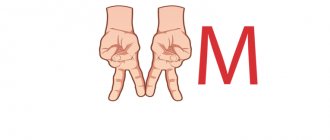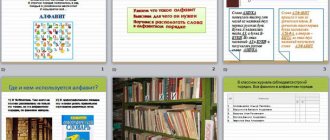A child's ability to reproduce sounds
When a baby is just born, he already has innate reflexes. One of them is the ability to respond to surrounding sounds. He responds to the words he hears by changing the rhythm of his movements and becoming animated. Already in the third or fourth week of life, the child reacts not only to loud, sharp sounds, but also to the speech of the people around him.
It is obvious that simple phonetic perception of words is not the key to successful learning to read. Human speech is extremely complex, and in order to understand it, it is necessary for the child to reach a certain level of mental and emotional maturity.
Researchers have found that the vast majority of children between the ages of six and seven cannot yet separate words into syllables. Therefore, literacy training in the preparatory group should be built in strict accordance with these features. Under no circumstances should you give a child a task that his brain is simply not able to cope with due to its immaturity.
The most popular method of teaching literacy
One of the sources of teaching activity was the book by K. D. Ushinsky “Native Word”, published in the 19th century. It outlined the basic methods of teaching children to read and write. Since reading was considered one of the most important elements of education, the issues of its teaching have always been very relevant.
It is highly recommended that you read this book before starting a Literacy Lesson. The preparatory group is the most difficult period of preparing children for the school program, so here you need to be extremely attentive to the individual mental and psychological characteristics of each child. Methods developed by linguists and teachers will help with this.
Ushinsky created a sound analytical-synthetic method of teaching literacy, which is based on considering letters not as individual elements, but as an integral part of words and sentences. This method allows you to prepare your child for reading books. In addition, it makes it possible to awaken children’s interest in literacy, and not just force them to mechanically learn and remember letters. It is very important. Ushinsky proposes to divide the entire teaching process into three components:
1. Visual learning.
2. Written preparatory exercises.
3. Sound activities to promote reading.
This technique has not lost its relevance today. It is on this basis that literacy training is built. The preparatory group, whose program is very rich, gets acquainted with reading in exactly this sequence. These stages make it possible to gradually and gradually present the child with all the necessary information.
Foreign literacy experience
So far, new methods developed by foreign specialists have not been widely introduced into the Russian preschool education system. The most popular two methods of education that came to us from other countries are the Montessori and Doman systems.
The first implies an individual approach to each child and comprehensive creative development. The second involves studying not letters and sounds separately, but entire words at once. Special cards are used for this. A word is written on each of them. The card is shown to the child for several seconds, and what is depicted on it is also announced.
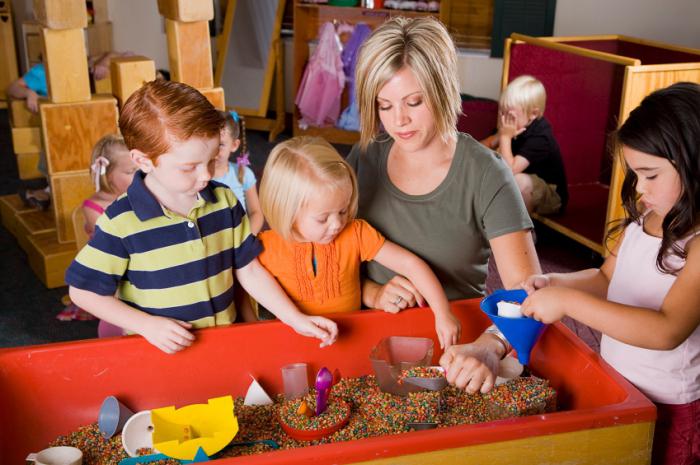
The Montessori method is difficult to implement in municipal kindergartens, since the number of pupils does not allow sufficient attention to be given to each of them individually.
The Doman system is criticized by Russian speech therapists, who claim that it is applicable for learning English, but not suitable for Russian.
Literacy training in the preparatory group according to Vasilyeva
One of the methods used in kindergarten was developed in the 20th century. Its author was the famous teacher and speech therapist M. A. Vasilyeva. She developed several programs for which you need to study. They are based on a natural sequence on which the “Literacy Teaching” lesson should be based. The preparatory group is intended for children who are already quite large and capable of understanding a lot. First, they need to be taught to isolate a separate sound, and then consider it in text accompaniment. This method has many features and advantages.
How does teaching literacy in the preparatory group proceed according to Vasilyeva’s method? The sound and letter “M”, for example, are presented as follows: first, the teacher simply shows images in various versions (graphic picture, three-dimensional, bright and multi-colored). Later, when this knowledge is consolidated, you can move on to the next stage. The teacher introduces the children to words that contain this letter. This allows you not only to learn the alphabet, but also to master the basics of reading. This is the most preferable sequence.
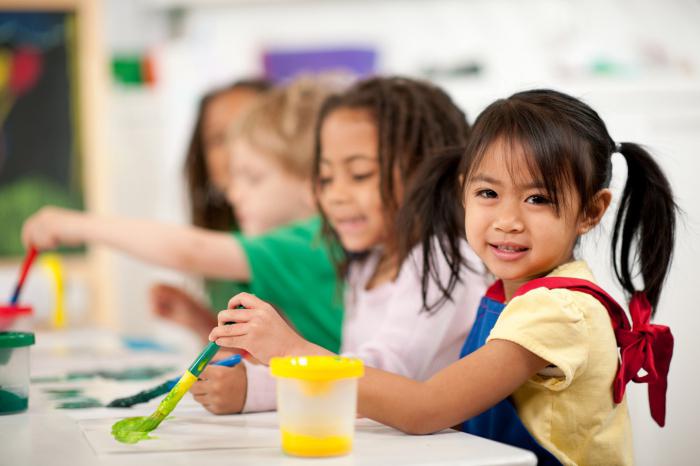
Planning literacy instruction in pre-kindergarten classrooms
If you go to a preschool in the middle of the day, you may get the impression that chaos reigns there. Children play in small groups, and some even sit on a chair and draw. But that's not true. Like everything else that happens in kindergarten, it has its own program and literacy training. The preparatory group, whose lesson planning is subject to strict recommendations of the Ministry of Education, is no exception. The program is drawn up for the academic year, agreed with the methodologists and approved by the person in charge of the preschool institution.
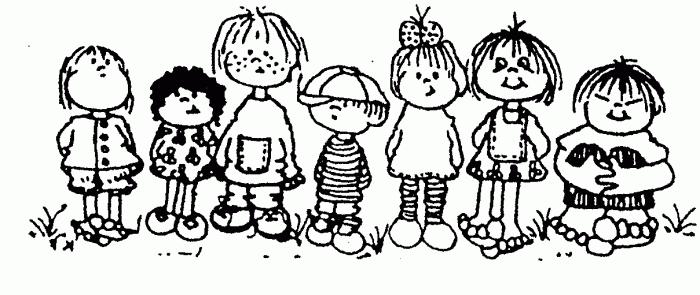
The direct process of learning to read and write
Methodologists of each educational institution are involved in the development of a program for introducing preschoolers to letters and sounds. That is why classes in different kindergartens can differ significantly. But, despite external differences, the meaning of the educational process is the same throughout the entire education system. It includes three stages already listed above.
Of course, when directly studying letters, the teacher takes into account many factors: the mood of the children at a given moment, their number, behavior, as well as other important little things that can improve or worsen perception.
Work program for teaching literacy “From birth to school”
- The sleighs are good, of course, but they are cunning: They go down the hill on their own, but pull them up the hill!..
Fairy tales
This verbal technique is great for motivating children, and also gives an idea of the language concepts that children encounter in the learning process, for example, the order of letters in a word. As an example, I will give a fairy tale about the word house: “In one bookish state there lived letters. And one day such a story happened there. The letters “D”, “O”, “M” decided to build a house out of cubes, only it kept falling down. The letter “O” kept running forward and trying to stand on the roof, offended that it was second and not first.
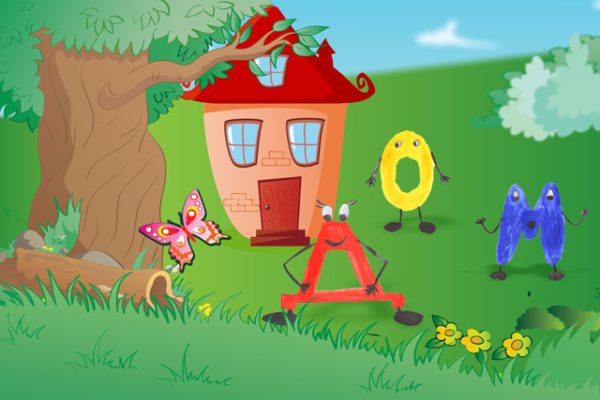
While telling this tale, you can show the following picture: the letter O is offended that it is not the first
The letter “M” didn’t want to be the last one at all and ran away. They looked for her for a long time in the book kingdom. When they found it, they put it at the end, the letter “D” was in front, and the letter “O” was second. Since then the house has stopped swaying and falling.”
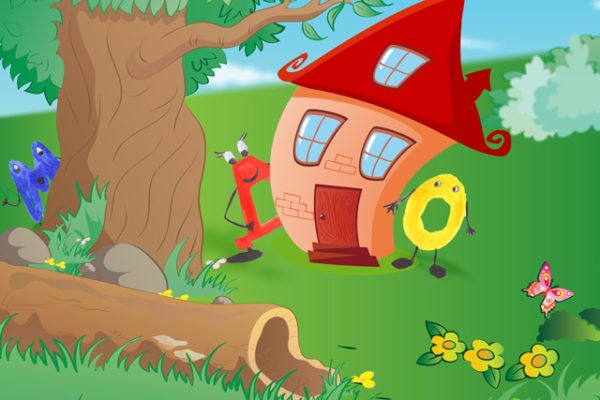
As the story progresses, children can complete letter search tasks
When choosing or composing fairy tales on a topic, you must:
- connect illustrations to the story;
- do not overload with characters and plot twists;
- use understandable vocabulary;
- maintain timing.
Reading
A technique that is actually the result of work on a literacy course. This skill must also be developed in the process of getting to know, practicing or consolidating the material. In other words, children, having mastered the required minimum of syllabic reading, can read words themselves - captions for pictures or phrases - instructions for games at the introductory or main stages of the lesson.
Tongue Twisters
An important technique for practicing speech skills is pronouncing tongue twisters. For children of older preschool age, they can also have humorous content (the kids will definitely appreciate this):
- Yogis flew to Yoshkar-Ola and ate yogurt along the way.
- Sharp horns The goat has Earrings. And Seryozhka said: “I’m a little afraid.”
Visual techniques
The fact that all tasks should be supported by illustrations has already been mentioned above. Therefore, we will focus on such important visual techniques as demonstration and display. The first presupposes the teacher’s personal example in one activity or another. So, in order to teach children to highlight a stressed syllable in words, the teacher first pronounces the words himself with an emphasis on the desired vowel, that is, he “sings” it. And if he is practicing writing a letter, he writes it down on the board several times, commenting on the order in which the elements are performed.
The screening includes children watching presentations and videos on the topic. For example, familiarization with sounds can begin with suitable excerpts from the educational cartoon “ABC for Kids,” in which sounds are presented through fairy tales. That is, children remember educational material as the plot develops.
Practical techniques
With the help of practice, children practice and consolidate knowledge, skills and abilities. First of all, it is worth noting the children’s work in copybooks, where they trace elements along the contours, write fragments of letters and gradually come to their full writing. In addition, the fixation of letters can be in the form:
| Type of games | Name | Goals | The order of game actions |
| Educational | "Name the Sound" | Learn to recognize sound by the movement of the articulatory apparatus | The teacher shows the pronunciation of the sound, the children guess what the sound is. To make it more difficult, you can show one-syllable and two-syllable words |
| "Lay out the pictures" | Learn to differentiate sounds (by similarity in pronunciation in an unstressed position, by hardness - softness, etc.) | Children give drawings depicting an object with the letter “a” to the doll Anya, and with the letter “o” to Olya | |
| Interactive | Contribute to the development of knowledge, skills and abilities on the topic. For example, “Learning the alphabet with Luntik” | ||
| Movable | “Guess and then catch up” | Develop phonemic awareness | The driver is put on a scarf or blindfold, and a participant comes up to him and calls him by name. If the driver guessed who called him, then he removes the scarf and runs after the player. If you manage to show off, then this player becomes the driver |
| "Rolling the Ball" | Expand your vocabulary on the topic | The teacher formulates a task, for example, to name as many pleasant words about mommy as possible. Kids throw a ball into a hoop or basketball hoop, saying words | |
| Theatrical | "Finger Boy" |
| Children put on finger theater puppets and illustrate the rhyme:
|
| Role-playing games, for example, “At the Doctor’s” |
| Children act out scenes based on the theme of the lesson, using words from special vocabulary (for example, tonometer, inhalation, etc.) | |
| Finger |
|
| |
| |||
- drawings;
- applications (for example, filling the contours of letters individually or as part of a word with cereal);
- crafts (3-dimensional letters, syllables or words, for example, made from plasticine or polymer clay).
Practical techniques can be indirectly related to the educational course, for example, creating an application with elements for the letters C and V
Gaming techniques
Three types of games are used in classes to teach the basics of reading and writing:
- training (for acquaintance, development and practical application of knowledge, skills and abilities);
- mobile (carried out to satisfy children’s needs for movement, but based on a relevant topic);
- theatrical (based largely on the personal experience of the children and consist in the presentation of material in the form of theatrical performances).
Table: examples of games for teaching literacy
How to personalize tasks
Speech development is an individual process, which means that literacy learning associated with it may also not occur in the same way for different children: some are good at identifying all the sounds in a word, while others have difficulty naming the first one. In this case, the teacher must try to individualize tasks.
In my practice, I encountered a problem when several children could not determine the number of syllables in words. I offered them the following task: I gave them 3-4 cards depicting animals (for example, a wolf, a fox, a dog) and 3-4 pictures depicting buildings. One had one window, the second two, the third three. The guys had to count the windows and vowels in the words - the names of animals, match them and thus find the owners of the houses.
In addition, you can individualize work with children using:
- additional tasks for those who perform basic tasks very quickly;
- memorizing (or retelling) texts for children with a slow speech rate or a small vocabulary;
- attracting unresponsive, shy children to prepare the room for class, that is, laying out materials on tables, preparing workplaces (this makes the kids feel their importance, and therefore experience a situation of success).
Individualization certainly includes one-on-one work.
⇐ Previous2Next ⇒
Recommended pages:
